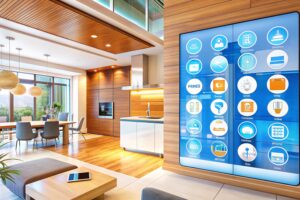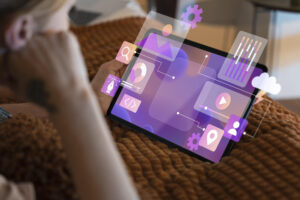
The rapid rise of AI and automation is transforming various industries, and interior design is no exception. As technology evolves, AI and automation are creating new opportunities for designers, making the design process more efficient, personalized, and accessible. From virtual design assistants to smart home integration, AI is reshaping how designers approach projects and deliver exceptional results for clients. In this article, let us explore how AI and automation are revolutionizing the world of interior design, making it more intuitive, data-driven, and adaptable to your unique needs.
Key Ways AI and Automation Are Transforming Interior Design
AI and automation are revolutionizing interior design, making it easier to create personalized, efficient, and innovative spaces. These technologies empower designers with advanced tools, transforming the way interiors are planned and customized.
1. Personalized Design Through AI-Driven Recommendations
 AI and automation are making it easier for designers to create highly personalized spaces by analyzing user preferences, browsing history, and even social media data. AI algorithms can gather insights on color preferences, furniture styles, and layout options, helping designers tailor every aspect of a room to a client’s taste. This level of personalization allows for unique designs that truly reflect the user’s lifestyle and aesthetics.
AI and automation are making it easier for designers to create highly personalized spaces by analyzing user preferences, browsing history, and even social media data. AI algorithms can gather insights on color preferences, furniture styles, and layout options, helping designers tailor every aspect of a room to a client’s taste. This level of personalization allows for unique designs that truly reflect the user’s lifestyle and aesthetics.
Personalized recommendations powered by AI also save time for designers, as the technology quickly identifies patterns and suggests ideas that would traditionally take hours to brainstorm. This enhances both creativity and efficiency, giving clients more options that align with their preferences.
2. Virtual and Augmented Reality for Real-Time Visualization
With the integration of AI and automation, virtual and augmented reality (VR and AR) are becoming invaluable tools in interior design. Designers can now create 3D models and renderings of spaces, allowing clients to “walk through” their future homes or offices before construction even begins.
VR and AR are driven by advanced AI algorithms that simulate real-world environments, making it easier for clients to visualize different design options, try out different color schemes, or experiment with furniture arrangements in real time. This process reduces the guesswork and allows clients to make more informed decisions, ultimately leading to higher satisfaction and fewer design revisions.
3. Automated Space Planning and Layout Optimization
 One of the most challenging aspects of interior design is space planning, especially in smaller homes or unique layouts. AI-powered tools are now automating this process by analyzing a room’s dimensions and functionality to optimize furniture placement and layout. These tools can generate various configurations in seconds, each maximizing the use of available space.
One of the most challenging aspects of interior design is space planning, especially in smaller homes or unique layouts. AI-powered tools are now automating this process by analyzing a room’s dimensions and functionality to optimize furniture placement and layout. These tools can generate various configurations in seconds, each maximizing the use of available space.
AI-based space planning also considers factors like lighting, traffic flow, and ergonomics, ensuring that the layout is both aesthetically pleasing and functional. This not only saves time for designers but also provides clients with optimal solutions for utilizing their space effectively.
4. Enhanced Materials and Color Selection Through AI
Selecting the right materials and colors is essential in interior design. AI and automation assist designers by analyzing vast amounts of data to suggest materials that align with a project’s style, durability needs, and environmental impact. These tools can also match color palettes that suit both the client’s preferences and the room’s purpose, enhancing the overall harmony of the design.
For example, AI can analyze a client’s existing decor to suggest complementary colors or materials that blend seamlessly with the room. This precision-driven approach improves design consistency, minimizes material waste, and supports sustainable design choices.
5. Sustainable Design Solutions with AI Insights
 Sustainability is a major concern in interior design today, and AI and automation play a critical role in supporting eco-friendly practices. AI-driven platforms can analyze the environmental impact of different materials, recommend sustainable alternatives, and even optimize energy efficiency in designs. Designers can now make informed decisions about eco-friendly products and create interiors that reduce energy consumption and waste.
Sustainability is a major concern in interior design today, and AI and automation play a critical role in supporting eco-friendly practices. AI-driven platforms can analyze the environmental impact of different materials, recommend sustainable alternatives, and even optimize energy efficiency in designs. Designers can now make informed decisions about eco-friendly products and create interiors that reduce energy consumption and waste.
With AI, designers are also able to factor in the lifecycle of materials, ensuring that each choice aligns with sustainable practices. This proactive approach enables designers to meet clients’ growing demand for environmentally conscious interiors.
6. Smart Home Integration with Automated Systems
AI and automation are fundamental to the development of smart homes, where devices and appliances are interconnected and controlled through a single system. Interior designers are now integrating smart technology to make homes more functional and efficient. With smart lighting, climate control, and security systems, designers can enhance both the convenience and appeal of a space.
Through automation, these systems can adjust to a homeowner’s daily routine, providing personalized settings based on their habits. AI-driven smart home integration not only adds a modern touch to interiors but also boosts energy efficiency, creating homes that are comfortable, functional, and environmentally friendly.
7. AI-Driven Trend Analysis for Innovative Design Ideas

AI and automation also empower designers by analyzing current market trends and predicting upcoming ones. AI algorithms can track changes in design preferences, popular color palettes, and emerging materials, providing designers with data-driven insights that keep them ahead of the curve.
This capability is especially beneficial in fast-changing fields like interior design, where trends evolve quickly. With AI’s trend analysis, designers can incorporate fresh ideas into their projects, making designs more innovative and appealing to clients who want the latest styles.
8. Automating Routine Design Tasks
AI and automation help streamline repetitive design tasks, such as drafting floor plans, creating itemized lists, or sourcing materials. By automating these time-consuming processes, designers can focus on the more creative and strategic elements of their projects.
For instance, automation software can generate quotes, manage project timelines, and track inventory, all of which are essential but mundane tasks in interior design. With these tools, designers can enhance productivity, stay organized, and ultimately deliver projects faster, benefiting both the design team and the client.
9. Virtual Consultations and Remote Collaboration

AI and automation have made it possible for designers to offer virtual consultations, allowing clients to discuss their ideas without the need for physical meetings. This is particularly advantageous for remote projects or clients in different locations. Through virtual collaboration platforms powered by AI, designers, and clients can share files, discuss layouts, and make real-time adjustments to designs from anywhere.
This shift towards remote work has increased accessibility to interior design services, allowing clients to engage with top designers regardless of geographic limitations. AI-fueled remote collaboration tools have also streamlined communication, making the design process smoother and more client-friendly.
10. Project Management and Cost Estimation
AI-driven project management tools assist interior designers by automating project tracking and cost estimation. These tools provide real-time updates on budgets, timelines, and resources, ensuring that projects remain on track and within budget. AI algorithms can even predict potential delays or cost overruns, allowing designers to address issues before they escalate.
By improving transparency and accountability, AI-enhanced project management tools ensure a smoother renovation or design process. They also help clients feel more informed, providing clarity on how their budget is being allocated and reducing the stress often associated with home design projects.
Conclusion
AI and automation have brought remarkable advancements to the interior design industry, making it more personalized, efficient, and accessible. From creating customized designs to optimizing space and integrating sustainable practices, AI tools are empowering designers to offer enhanced services that align with client needs and current trends. With continuous technological advancements, the potential for AI and automation in interior design will only expand, opening up new opportunities for innovation.
Ready to turn your dream home into reality? Book an appointment with E³.SPACE, and let us bring your vision to life.
